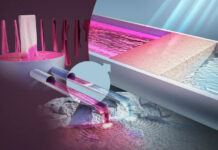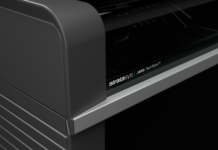One of the reasons why made in Italy, especially in textiles and fashion, grows sales rankings in the world also lies in the ability of the Italian manufacturers to constantly work on improving quality and efficiency. Although Italy never appears among the countries that annually register the highest number of patents (an element that is normally associated with innovation), what the economist Giacomo Becattini called the “Italian hornet” continues to fly and if it succeeds in doing it the merit is precisely the small but continuous improvement and adjustments that companies apply to their processes.
The ETV Elettronica Tessile Varese is just one of those companies that make the “hornet” not only get up in flight but also travel considerable distances: the company of Induno Olona produces devices in the field of temperature measurement and humidity in the fabric and is the only one in the world to cover all phases of the textile supply chain, from raw fiber to fabric, with small applications that are able to make substantial savings in terms of time and costs, improving the quantity.
Thanks to the experience in the field of residual moisture control in the textile industry in 1968, Giuseppe Sempio in collaboration with a partner, founded Elettronica Tessile Varese based not by chance in the province of Varese to be barycentric compared to the textile districts of Biella, Como and the North of Milan province. Since 2001 the company, now ETV, is in the hands of his son Maurizio Sempio, supported by the partner Damiano Albini since 2008, and today its customers are located all over the world because his instruments are purchased both by textile machinery manufacturers and by textile companies that want to implement theirs already in use machines. And the market, there is perhaps not even need to say it, it is not only Italian but is now international.
«Today 30% of our production goes abroad through direct sales – the financial manager, Damiano Albini, explains- but of the remaining 70% sold in Italy, especially to textile machinery builders, an important percentage ends in all the foreign countries that are investing in this sector. In recent years we have pushed a lot on internationalization and thanks to this decision we have increased our turnover by over 25%».
The hardware and software devices built by ETV generally go to integrate machinery such as rameuse, sizing machines, sanfor and dryers to accurately measure the residual moisture in fabrics, yarns and paper, but also (and here lies the uniqueness that fully covers the supply chain) also in tops and flocks.
For textile finishing process
Since 2001, the temperature control of the fabric has been designed and included in the range of products which, together with the recording of residual moisture percentage, form a fundamental junction in the textile finishing process, where dyeing, printing and finishing are included, naming washing and drying.
SFERA PLUS, the complete control system that is used in these last two steps, is able to constantly monitor this process but above all to optimize it. «Traditionally – Maurizio Sempio tells – in textile the stenter’s passage, that is the drying and thermofixing of fabrics, is based on a series of parameters such as temperature, the stay time in the fields, the type of fibre of which the material is composed. But the combination of the three elements is very often managed on the basis of the great know-how, the experience of using the machines and comparing the results over time. Our sensor system integrates the stenter, returning in real time the real temperature of the fabric along the entire passage and its residual moisture, allowing an optimal automatic adjustment of the machinery, which therefore consumes less energy and works faster, decreasing the production time and eliminating reworking».
A numerical example can be useful: without knowing what the real temperature inside the stenter is, the passage is based on experience and the data show that fabrics generally remain much more often in the machine than necessary. On the other hand, if the actual temperature is known, the stay time can be decreased and the output speed increased. Indeed, increasing the speed by just one meter per minute on a production of 200,000 meters of fabric per month, it means obtaining 10,000 meters of extra fabric per month without additional costs, but these sensors allow much more than this.
The only cost is the investment in the ETV device that, however, can be quickly amortized. The increase in productivity is then associated with a better use of energy because the stenter’s temperature can be managed with great precision and, if you also know the humidity of the exhausted air (the one expelled from the machine), you can adjust the exhaust velocities, which are usually left at maximum power.
More productivity more optimization
This same optimization can be achieved on all the dryers, on the tops/ribbons or flocks, on the yarn reels and on any textile material of which the quantity of evaporated water present must be known. ETV control systems are also available to verify the shrink and elongation of fabrics and yarns, but there are software and hardware for the entire production chain, machines for the automatic application of labels, marking of defects, yarn breakage and antistatic bars for the dissipation of electrostatic charges.
«They may seem like little tricks in relation to the complex economy of a textile production – Sempio underlines – but in reality they can guarantee big returns in terms of efficiency. And considering the level of world competition, we believe that today no improvement can be left out. The technical consultancy that we carry out demonstrates with the numbers that there is a convenience in adopting our devices and, if I may say so, we can reach it with very low investments. This is our strength, a real advantage at small costs».







